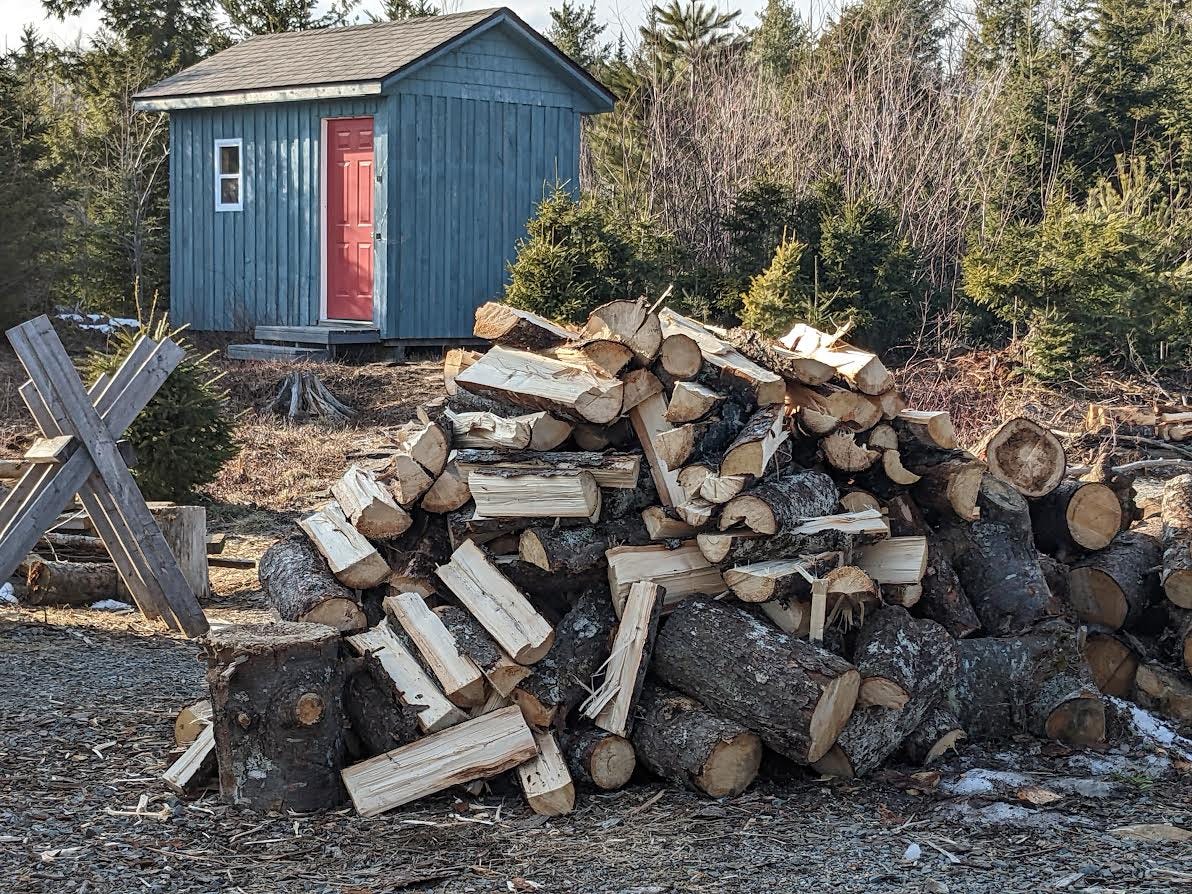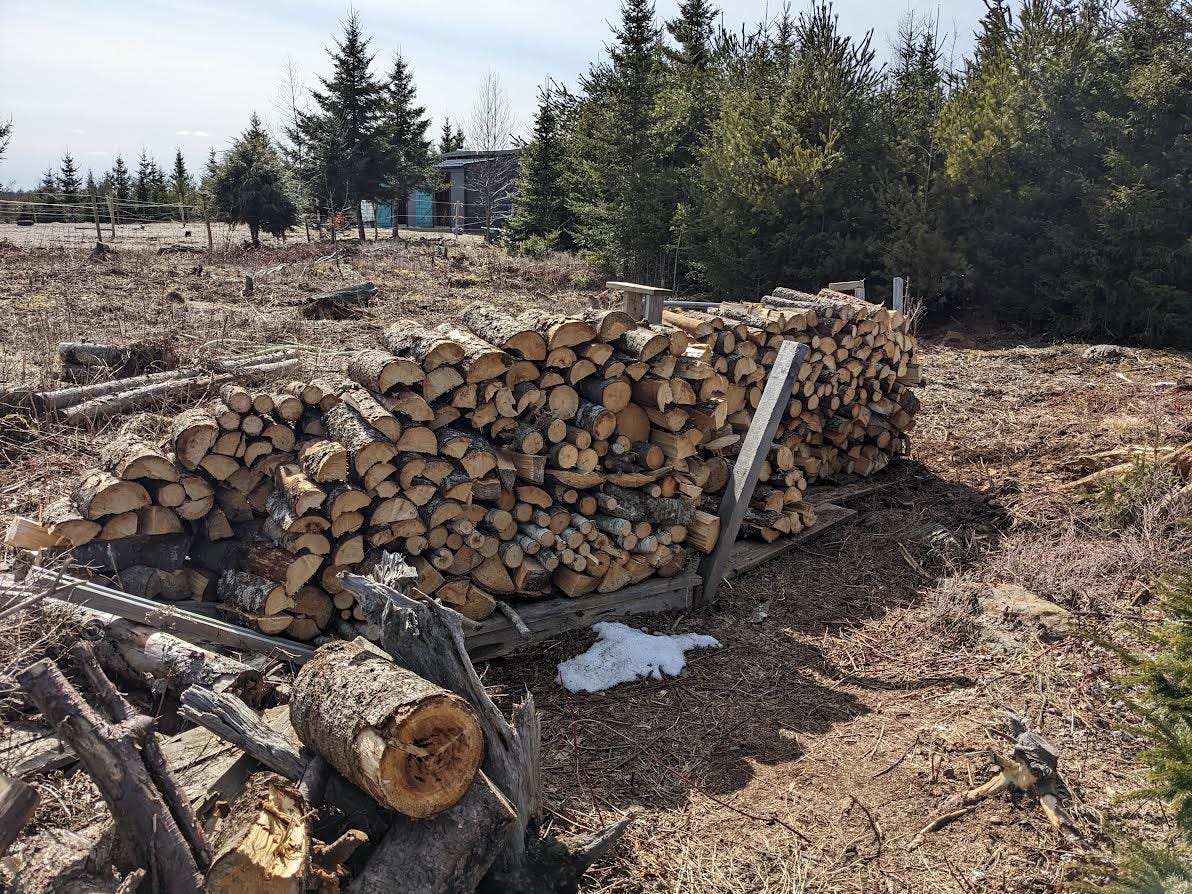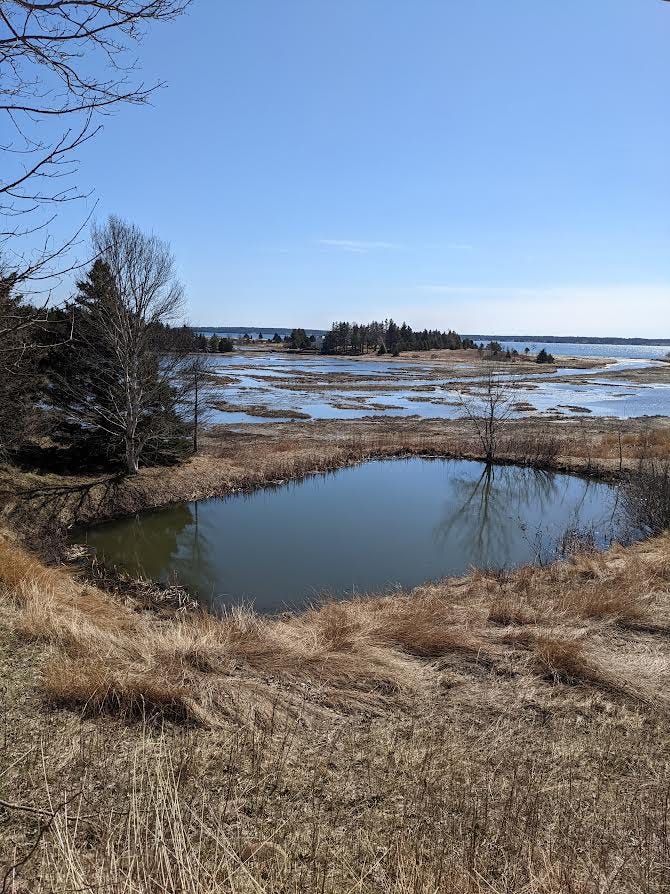This morning as I stacked split wood on the outdoor pile for next winter, I noticed something that I don’t believe I had in previous springs. It was noisy. The birds filled the air with chatter. I think life is returning to the marsh surrounding our home in greater profusion than before.
The last couple of nights a flock of geese have settled near by, their quarrelsome gabble filling the air. Last year we might have heard a couple flying overhead. The previous year, none.
At the same time, chickadees, and warblers are joyfully singing their songs of spring.
Not everyone and everything is happy though.
A pile of eviscerated rabbit guts - brown, pink and red on the white snow bank beside the lane - speak to a murderous bobcat. We had to yank the dogs away from what they viewed as a mid-morning snack.
And perhaps that explained their wild romp later that same day. Blink, and they vanished. Gone up the lane, into the woods, down by the brook, who knows? All we knew is suddenly we had three dogs missing on 64 acres of wild land.
Who could blame them? The scents of spring are on the land; the wildlife calls to them, beckons them further afield. What a time to run through the woods, sniffing at the mosses, chasing the chatter of squirrels! Abandon! No sense of duty, just the vast sense of exploration opening the world ahead for them.
Thankfully, the missing rapscallions turned up again with their muddy paws. The latter provided the clue that most likely they had charged up the lane.
The dogs might have been no worse for the wear, but my nerves get worn down every time they run off like that.
What brings this charged sense of change to Three Dogs Marshland? The previous owner enjoyed hunting. Now, three years later, the marsh is returning to a preserve, and the wildlife senses safety perhaps.
I’m not a biologist, nor an ornithologist; I’ve spent at least as much of my life in cities as I have in rural, wild places. But I see and hear a difference. Perhaps, it is just a natural spike in population for the one year; but this morning as I continue to place one wood block after another onto the stack, I just know deep down inside of me that the marsh is wilder than before.
Cars line the road to Carters Beach in 2020. Photo courtesy of Leanora Fisher.
Our neglected shoreline: the big picture
“The pamphlet started by bemoaning the ubiquity of such signs in coastal areas such as Private Property, No Trespassing, and Subdivision Lots for Sale. It warned bluntly that seashores were being mauled by excessive commercial and residential developments.”
The same document also made clear that “oceans were being jeopardized on and offshore by oil and gas exploration, engineering projects, mining, housing, motel strips, and high-volume tourism. Tidal pools and dune habitats of shorebirds and nesting turtles were being destroyed by reckless commercial developers.”
Nova Scotia in 2023?
Nope.
Would you believe a 1955 report lamenting coastline development along 3,700 miles stretching from Maine to Texas. The U.S. National Park Service’s missive was titled A Report on a Seashore Recreation Area Survey of the Atlantic and Gulf Coasts.
The latter is recounted in American historian Douglas Brinkley’s authoritative and magnificent recollection, Silent Spring Revolution, which I’ve previously written about here.
Here we are in Nova Scotia, 68 years later, and we still don’t have a policy document designed to protect the provincial coastline. Point of fact, is we’re waiting on the first such one sometime early this year supposedly.
In the meantime, our provincial coastline, all roughly 13,000 kilometres of it, is still awaiting some sort of protection. The latter is badly needed.
It’s not to say Nova Scotia’s coasts haven’t been studied, but protected? Well, that’s a different story.
The province published its State of the Nova Scotia’s Coast Report in 2009. At that time, it called the report the first of its kind in Atlantic Canada, which examined six priority issues: sea level rise and storm events, public coastal access, working waterfronts, coastal water quality, coastal ecosystems and habitats, and coastal development.
Perhaps one of the most eye-opening facts from the report is that 86 percent of the province’s coastline was privately owned at the time of the report.
Justin Huston, chair of the Provincial Oceans Network, the group of 15 departments and agencies that oversaw the development of the report, wrote: “This report is a snapshot of the current state of the province's coast, including its history. Using feedback from Nova Scotians, as well as information in the report, a coastal strategy will be developed for release in 2010.”
In 2011, Dalhousie University prepared a report on the state of the province’s coastlines titled the 2009 State of Nova Scotia’s Coast Report: An Initial Study of its Use and Influence, which was released as an educational tool informing the public on coastal issues.
The report itself was meant to help meet the 2007 Environmental Goals and Sustainable Prosperity Act (EGSPA) that set out 23 specific goals “to fully integrate environmental sustainability and economic prosperity” within Nova Scotia by the year 2020. Given that is the case, the fact that the first protection act here won’t be ready until the first half of this year suggests that at this point that overriding goal is three years late.
“While the Coastal Protection Act was passed in 2019, it will not take effect until the accompanying regulations are fully developed and approved,” a story in Environmental Science and Engineering Magazine noted. “At that time, a new coastal protection zone will extend around the coast of Nova Scotia and new requirements will apply to constructing houses and other structures in the zone.”
The publication noted the proposed act drew some 250 comments, with many split, arguing that restrictions on development are too restrictive while others didn’t believe it was restrictive enough.
“While the decision to restrict the use of vulnerable coastal properties may be difficult, protecting Nova Scotia’s coastline is the right thing to do, both for our financial well-being and for the environment,” Amanda Dean, VP of the Insurance Bureau of Canada’s Atlantic region, told the magazine.
At this point, it is apparent that legislation to protect Nova Scotia’s shoreline is long overdue. Currently, there is an outcry over a Halifax developer who has erected a wall at Little Crescent Beach in preparation for three cottages he intends to place there.
But that is far from the only incident impacting the provincial shoreline at the moment.
CBC recently reported as well that “Nova Scotia has quietly imposed a moratorium on applications for new marine fish farms until it assesses, maps and rates the coast for suitable locations.
“Since the Progressive Conservative government came to power in 2021, Nova Scotia Fisheries and Aquaculture Minister Steve Craig has not issued options to lease open-net pen sites — effectively closing the door to entrants.”
That’s all good and fine, but the public needs to remain informed as a stakeholder in our shorelines. And again this points to a patchwork of different policies that need to be unified into a larger vision to preserve not only the region’s natural beauty, but the thriving life that should not have to fight for survival from the ongoing threat of development.
Over at the Minas Passage, a tidal power player has withdrawn its application, citing frustration with the Department of Fisheries and Oceans. Sustainable Marine Energy said after three years of delays it is “coming up against a brick wall.”
While the sustainable power company pointed to a “lack of alignment with other government stakeholders,” it is perhaps not possible to line things up without the proper provincial legislation in place to offer shoreline protection and guidance.
In Queens County, at the incredibly popular Carter’s Beach - a white sand beach with clear blue water - the province proposes to increase access. Yet the annual, seasonal influx of tourists causes residents complain that in the summer the access road is choked to the point where emergency vehicles can’t access it if necessary. Litter and crowds are also an ongoing problem.
In the provincial government’s capital plan for infrastructure, it cites, among other things, that “provincial parks are also getting some attention from the province this coming year. The capital plan includes $10 million for upgrades and repairs, including a new washroom at Lawrencetown Beach, accessibility improvements at Rainbow Haven Beach, and a parking lot, toilet and beach access at Carters Beach,” according to the CBC.
The clock is ticking. What is the legacy we will leave for our children and theirs when it comes to the province’s shore? One where development has choked the shoreline to the point where access is no longer available and pollution has spoiled the once pristine regions? Or will we find a way forward to preserve one of the province’s most precious and irreplaceable assets?
We’re already 68 years too late with a comprehensive shoreline protection plan. The one that is proposed undoubtedly does not contain everything for everyone, but to even have a plan in place would be a good starting point.
Please, let’s not wait another 68 years before it’s too late.
The truth about Chickens - Birds of Satan.
My friend and fellow Substack newsletter writer across the pond - and by across the pond, I mean over in New Zealand - Ian Apperley, writes an extremely funny post about chickens. Funny…but true.
“We have a few chickens on the farm, and before moving here, we also had chickens in suburbia for several years,” Apperley notes. “In all fairness, they are an interesting bird, and so this is tongue in cheek, but they are also complete bastards at times. Here are a few things you should know before rushing out to buy them.”
You can read the entire post here.
I also encourage you to subscribe to Apperley’s Substack: The End of the World: From Urban to Bucolic. He writes about rural life, politics, and his journey, humour, and politics as he transitions from city-life to farmer.
What I’m reading
…will return next week.
What I’m listening to
It might not be so easy to find this particular disc as it was a limited edition, sampler CD issued in 2003 and included in an issue of Jazziz Magazine.
Jazziz on Disc contains tracks ranging from the blistering bass of Jaco Pastorius and Victor Wooten on Teen Town, to the laid-back vocals of Kurt Elling on In the Winelight. The music spans the Africa-inflected funk of Nicholas Payton’s wicked trumpet playing on Fela 2, a composition that itself recalls Mile Davis’s fluid playing; contrasted with the rapid attack of Gianiugi Trovesi Octet. Steve Oliver’s guitar track has a South American lilt to it
Fortunately, while this CD may be hard to come by, all of the songs are contained on the artist’s original recordings. For someone who already loves jazz but only has a moderate knowledge of the music, it’s a great introduction both to a number of artists and different styles within the genre. For example, I’d never hear of Lori Carsillo, but on her version of Get Out of Town her sultry voice begins to blur from annunciated lyrics into scat, transforming into one of the composition’s instruments in the process.
The only thing I could have wished for with this recording is comprehensive liner notes. I would have loved to have known, for instance, who the backing band for Carsillo was as they provided splendid accompaniment.
Otherwise, this sampler is a fantastic idea. Of the 16 artists represented here, I’d search out the music of all of them, a number of whom I’d never heard before.








https://novascotia.ca/coast/docs/part-1-Overview-of-proposed-Coastal-Protection-Act-Regulations.pdf
Good Reminder that we are still waiting on Coastal Protection regs. Thx.